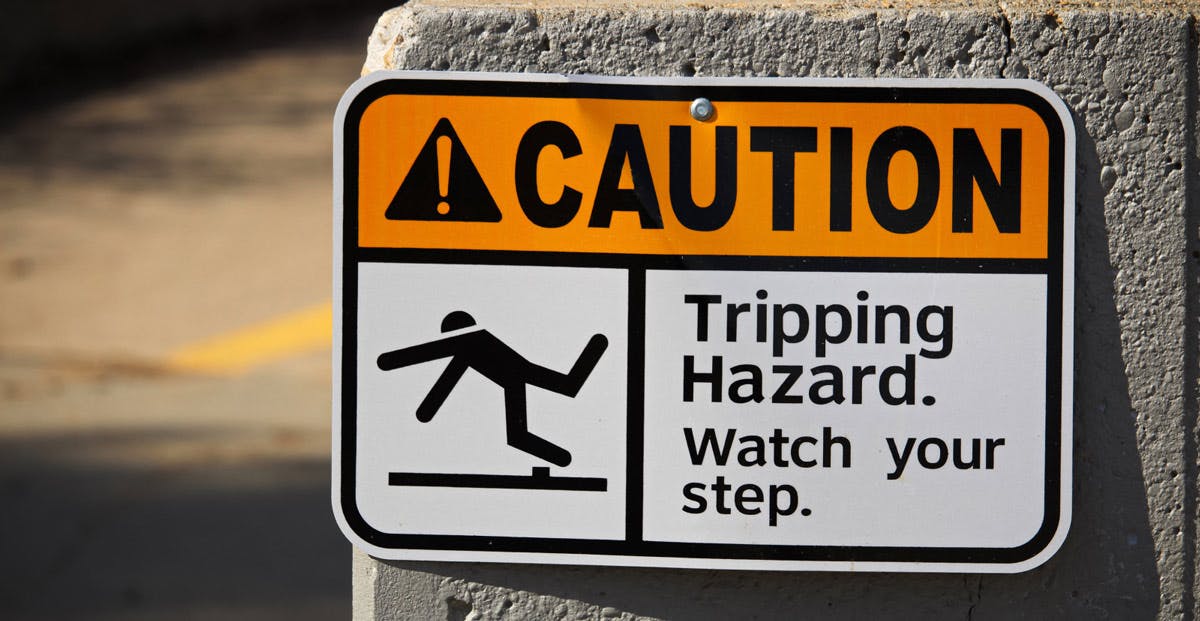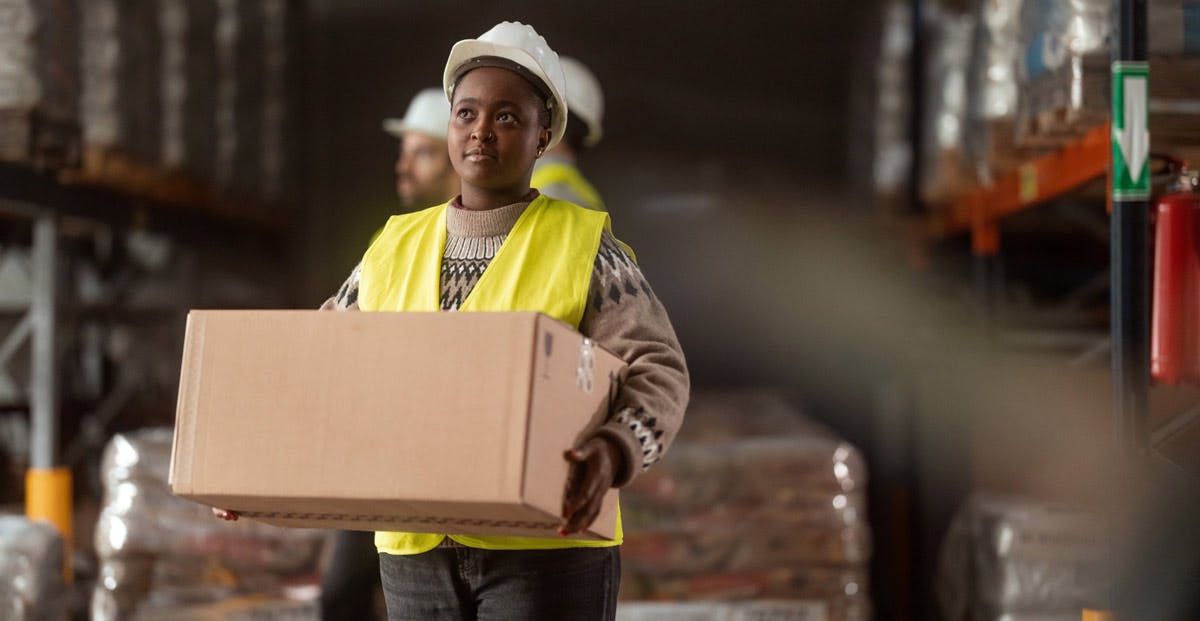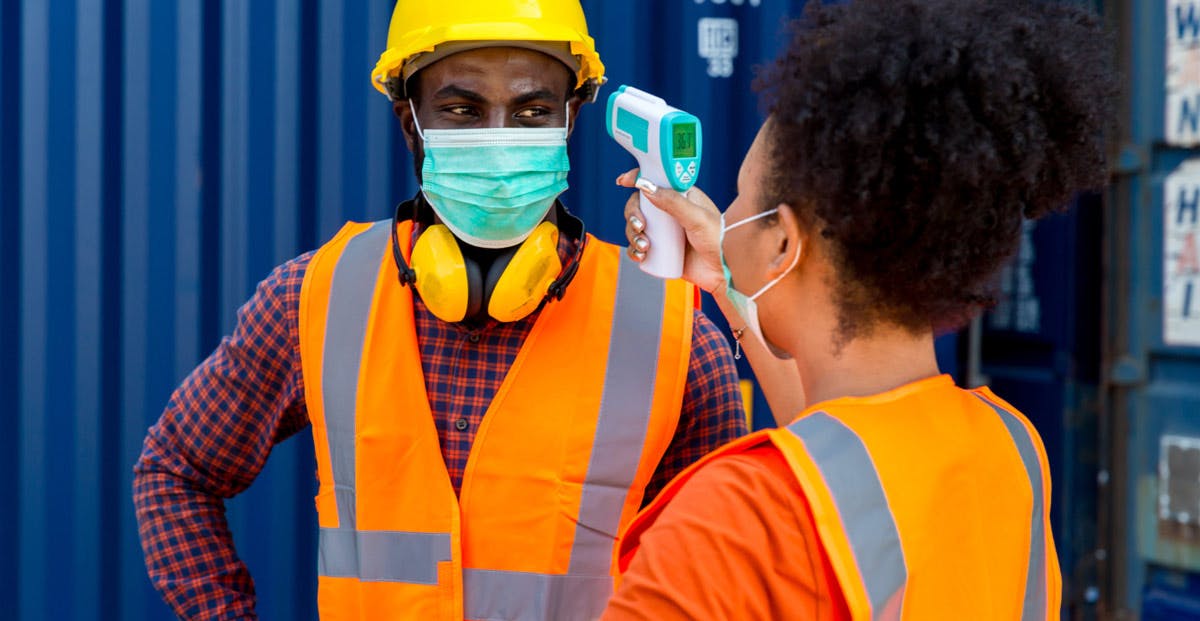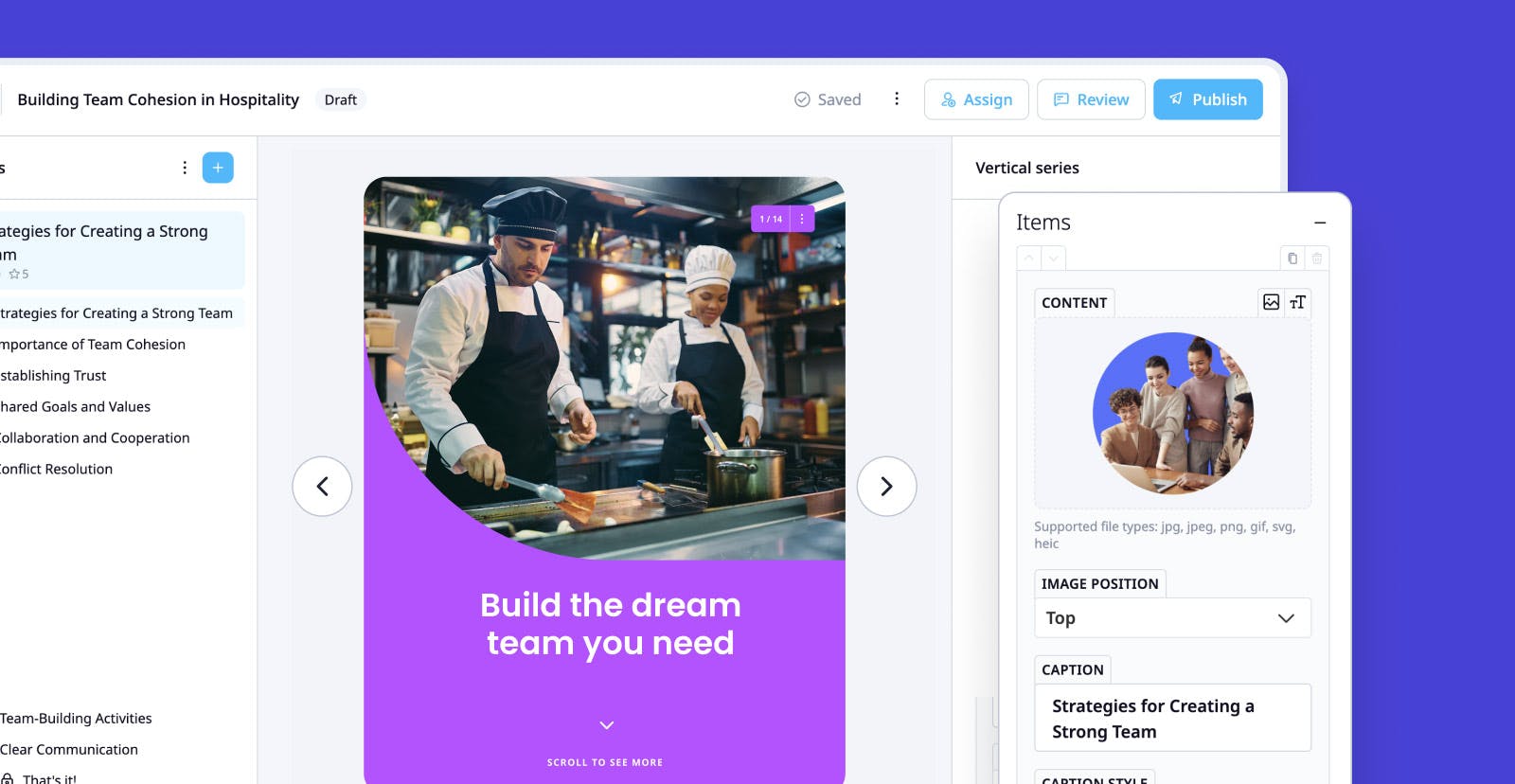10 Safety Topics for Work

Raising awareness of the most relevant safety topics for work is the key step in fostering a safe and healthy workplace culture and environment. Whether your employees work on a construction site or spend long hours at an office, they must be constantly alert and aware of the inherent dangers in their surroundings.
To help you out with your research, we’ve selected 10 safety topics for work that you can incorporate into your training program.
What are safety topics for work?
Safety topics for work refer to the various safety aspects that employees need to be aware of to protect themselves and their colleagues from harm in the workplace. Depending on the industry you’re in or the type of work being done by your team, it’s up to you which safety meeting topics you want to prioritize.
Fire safety, electrical safety, ergonomics, personal protective equipment (PPE), managing hazardous materials, and preventing workplace violence are just some of the most common safety topics at work. To maintain a safe and healthy workplace, it is the responsibility of both you and your employees to see to it that these safety topics are understood and followed.
1. Slips, trips, and falls
Slips, trips, and falls occur more than one might anticipate at work. According to the Bureau of Labor Statistics, they account for nearly 700 incidents per year, resulting in workplace injuries like cuts, bruises, and fractures, and more fatal consequences such as impairment of the spinal cord and nervous system. The most common factors in these incidents are wet and slippery floor surfaces, poor lighting, unsuitable footwear, and unstable walkways.

While you may be imagining them in more hazardous job sites like construction and manufacturing facilities, slips, trips, and falls can also happen within the four walls of your office space—either tripping over a box or slipping on a newly mopped floor.
Raising this safety topic for manufacturing, construction, or sports activities safety meetings and giving learning resources like fall protection training courses will alert your employees on the most common slip, trip, and fall hazards, like where and how they can occur, and from there, follow the right precautionary steps to minimize and eliminate the risks.
Recommended online resources on slips, trips, and falls:
- Safety in the Workplace by SC Training
- Ladder Safety by SC Training
- Slips, Trips & Falls by High Speed Training
- Slips, Trips and Falls by Aveling
2. Proper use of Personal Protective Equipment (PPE)
Personal protective equipment (PPE) refers to specialized clothing and equipment that protect industrial workers dealing with hazardous chemicals, heavy construction materials, loud equipment, and also health care providers working around patients exposed to potentially infectious diseases.

If your business falls under any high-risk industry requiring the use of such protective equipment, it is integral that you keep open communication with your team and discuss with them the specific type of PPE they need for their job, as well as its correct use, storage, and maintenance. You can do this through safety talks, safety briefings, or even short safety presentations.
Plus, you must also educate them on the core reasons why they need such protection for their job and the health and physical risks of not following the right way of wearing and using their PPE. This safety topic for work isn’t only relevant upon onboarding, but it should be discussed regularly among your existing employees.
Recommended online resources about Personal Protective Equipment (PPE):
- Personal Protective Equipment (PPE) for Construction by SC Training
- Personal Protective Equipment by eSafety
- Introduction to Personal Protective Equipment (PPE) by Safetyhub
3. Workplace Ergonomics
Workers in physically demanding industries like manufacturing, retail, and services perform strenuous and repetitive tasks like lifting, assembling, pulling, and bending. Without proper ergonomics practices, these tasks may result in fatigue and discomfort, leading to frequent body aches and pains, and sometimes even musculoskeletal disorders or permanent disabilities.

Establishing good ergonomics in your workplace—like using devices and equipment for lifting and transporting heavy materials, installing anti-slip and anti-fatigue mats, or changing tables and chairs’ positions to improve posture—goes a long way in lowering the chances of injuries and at the same time improving their daily productivity. These practices must be communicated clearly with your workforce to ensure effective reinforcement and implementation.
Recommended online resources and safety topics for meetings about workplace ergonomics training:
- Ergonomics for Manufacturing by SC Training
- Ergonomics for Retail by SC Training
- Ergonomics Training by Sentrient
- Office Ergonomics by Choice Training & Consultancy
4. Drugs and Alcohol Misuse in the Workplace
Drugs and alcohol can impair your employees’ physical and mental state, causing a wide array of problems at work, like loss of production, absenteeism, and worse, fatalities and accidents.
Hosting a training program or seminar on this safety topic for work will help open their minds about the physical and health risks of these substances, as well as encourage them to become more responsible in building a safe, drug-free environment. Maintaining responsible behavior at work will result in higher productivity and work quality with fewer injuries—a win-win situation for both the company and the employees.
Recommended online resources about drugs and alcohol misuse:
- Drugs and Alcohol in the Workplace by SC Training
- Drug and Alcohol Awareness by Emtrain
- Drug and Alcohol Prevention at Work by Everfi
5. Road and Driver Safety
While it’s nearly impossible to promise 100% safety on the road, you can always reduce the odds of accidents by increasing your team’s knowledge about the most common road hazards and the safest practices that they can adopt while driving.
Tackling this safety topic for work is even more crucial if you are managing transport and shipping truck drivers, who are mandated to expedite products and services in the quickest but safest way possible to satisfy customer demands. It is crucial to educate your drivers about the trucks they are driving and the pickup parts they are using for the safest service possible.
For your road safety training, you can talk about the techniques and strategies of defensive driving to urge your workers to drive more safely around other vehicles. You can also roll out quizzes and assessments that will refresh their mind with the basic traffic rules and regulations, ensuring a safe journey while on the road. You can also highlight the grave consequences of reckless and drunk driving so they can commit to smarter and safer driving.
Recommended online resources about road and driver safety:
- Driver Safety by SC Training
- Defensive Driving for Heavy Vehicles by SC Training
- Extreme Weather Driving Training by REED
6. Electrical Safety
While it’s needless to say that addressing electrical safety hazards is crucial for electricians, construction workers, mechanics, and many others in similar fields, this safety topic for work will also benefit those concerned with office workplace safety. Even more so these days, wherein most work activities are heavily reliant on gadgets, tools, and equipment, which operate on electricity.
All are aware of how damaging electrical incidents can be—live wire contacts can cause electric shocks leading to cardiac arrest; electric short circuits and overheated wires can trigger a fire easily; and an arc flash can result in burns, blindness, and hearing loss. Still, they can be prevented if your employees are well-versed in basic safety measures, especially when working around electrical equipment, and the right steps to follow when responding to any related emergencies.
Recommended online resources about basic electrical training:
- Electrical Safety by SC Training
- Controlling Hazardous Energy: Electricity by SC Training
- Basic Electricity by 360training
- Basic Electronics and Electricity Course by TPC Training
7. Fire Safety and Evacuation Plans
Unfortunately, no industry is exempt from fire hazards. From loose wires and overloaded plugs in office rooms to improper storage of combustible materials in manufacturing facilities, a fire breakout can occur anytime and anywhere. Without a proper fire and emergency plan in place, this event can cause catastrophic consequences such as property damage, burns and injuries, and worse, even death. Moreover, if your building has a door access control system in place, employees need to be trained on how to use this system during an evacuation or when there is a fire danger.
Having an organization capable of identifying and mitigating fire hazards is your key step towards fire prevention. Every now and then, it will be helpful to refresh their minds on the basics of fire safety, the precautions they need to take, and the right use of alarm systems and fire extinguishers. It’s also a good idea to create an emergency action plan beforehand and make sure that your team is fully prepared for its execution. This way, you can rest assured that they know exactly how they should respond and how to observe an orderly evacuation in case of a fire breakout.

All fire department members are committed to protecting their fellow citizens in times of need. Not only can they fight fires, but they can also work to prevent other disasters from causing unnecessary loss of life and property. It is also the responsibility of firefighters to assist in the event of other disasters. In collaboration with other emergency response agencies, firefighters protect personal safety, save lives, save property, and protect the environment, accomplishments that are often recognized with personalized coins.
The fire department challenge coins are small but very solid. What better souvenir for a firefighter than a Firefighter Challenge Coin? A Firefighter's Challenge coin stays with them throughout their tenure as a testament to their contributions to the community. The meaning it represents is priceless!
Recommended online resources and oil field safety topics about fire safety and evacuation plans:
- Fire Safety by SC Training
- Fire Protection by SC Training
- Evacuation Plan by SC Training
- Fire Prevention Plans by OSHAcademy
- Fire Emergency Evacuation Procedures by Safety Services Direct
8. The Basics of First Aid
In its most basic form, first aid is initial emergency care given to an ill or injured person, just until a professional medical service arrives in place. It can help save lives, hinder temporary and long-term disabilities, and prevent any emergency from becoming worse. With this in mind, it makes a good business strategy to train your employees on the basics of first aid and EMS training as it will help you secure a healthier, safer workplace environment for your workers.
Some of the most useful first aid procedures that you can include in your safety training are treating bleeding and fire burns, carrying out CPR (Cardiopulmonary Resuscitation), nursing a person who has fainted, and responding to sprains and bone fractures. It is also worth discussing how they can perform assessments and file incident reports whenever needed.
Recommended online resources about first aid training:
- The Basics of First Aid by SC Training
- Workplace First Aid Online Training by High Speed Training
- CPR, AED, and First Aid by Alison
- First Aid at Work by Echo3
9. Fatigue & Stress Management
Another safety topic for work that is worth discussing with your team is coping with fatigue and stress management. Living and working in a fast-paced world with incredibly high customer and client demands, fatigue and stress have been a common and unfortunately normalized problem in the modern industry. They are, in general, the result of skipping lunch breaks and missing days and weeks of sleep due to long duty periods, heavy workloads, and cranky deadlines. If not immediately addressed, they can impair cognitive and body functioning, sometimes even permanent impairment, and long-term mental problems, like anxiety and depression.
But fret not, achieving a healthy, low-stress work environment is feasible. Regularly reminding your employees of the common causes of work stress and fatigue and their implications for their mental and physical state is a strategic place to start. You may also want to consider sharing with them some learning materials and resources to help them develop positive coping strategies and some relaxation techniques to reduce strain and stress.
Recommended online resources about fatigue and stress management:
- Fatigue Risk Management by SC Training
- Managing Leadership Stress by SC Training
- Stress and Fatigue in the Workplace by Besafe Training
10. COVID-19 Awareness and Preparedness
Last but not least in this list is increasing your organization’s awareness about COVID-19 and improving their preparedness and response action. According to experts, among the best ways to reduce the chances of coronavirus infection is to provide your team with reliable and accurate information about the virus, like how it spreads and what symptoms to look out for.

If your workforce is finally returning to work, it is also recommended to discuss with them the guidelines and safety measures set by the World Health Organization (WHO) and Centers for Disease Control and Prevention (CDC). It’s also crucial that they’re given clear instructions on what to do if someone on the team gets sick with the new coronavirus.
Recommended online resources for COVID-19 training:
- Let’s Kick COVID-19! by SC Training
- Covid Training Course (COVID-19) Coronavirus Essentials by Grey Matter Learning
- Understanding the COVID-19 Pandemic by Johns Hopkins University Experts
Safety Topic of the Day
To increase accuracy and efficiency in tasks like lifting and carrying bulky goods, heavy machinery is utilized in sectors like construction, manufacturing, and shipping. Heavy equipment includes large machines and vehicles including cranes, forklifts, bulldozers, and many others.
Because of how dangerous these equipment and vehicles are, operating them or being near them places a great deal of responsibility on the shoulders of personnel. It can result in accidents or even fatalities if you don’t know how to use them safely.
Go beyond simple safety topic talks
Although, it's everyone's responsibility to emphasize the importance of safety at the workplace, funny safety topics are a great way to break the ice during toolbox talks. Consider compiling and sharing funny safety moment topics without ever taking workplace safety lightly. Just a great way to keep your employees engaged with training.
Promote workplace safety with Training by SafetyCulture
Free online learning platforms like SC Training offer an easy way to put together 5-minute safety topics for work and share the content with your team. Thanks to their responsive authoring tool and microlearning templates, all you need to do is copy and paste your workplace safety content or import your existing training materials, hit publish, and you’re all good to go.

With SC Training, you’ll also discover a comprehensive e-learning course library of beautiful, world-class learning resources, created in collaboration with some of the most reputable brands and thought leaders in the world. There are courses about safety ladder safety, electrical safety, PPE use, and even other safety topics like food safety hazards, food contamination training courses, and more.
They are structured into topical, bite-sized chunks, enhanced with powerful features like gamification elements and an online quiz maker to improve the learning experience of your employees. This platform has also made most of their courses editable so that you can easily edit, rebrand, and personalize them with ease.
To reiterate, there are several opportunities to communicate hazards in the workplace and safety practices to your team:
- Set up a meeting or a conference
- Host a webinar or online training if you’re handling a remote team from different parts of the world
- Roll out e-learning or mobile training courses
- Organize blended training (a combination of traditional face-to-face and online training)
However, keep in mind that the success of your safety awareness training or program doesn’t solely depend on your training delivery method. You also need content that will not only engage your employees but also offer them exciting learning opportunities. This way, they can deter complacency and avoid common safety-related workplace incidents and injuries from occurring.
A great way is to use engaging learning content and topics. You can even mix it up with funny safety talks and funny safety presentations. Although safety isn't a joke, integrating some funny safety topics for work can help normalize safety culture at your workplace.
Start using the best safety training platform today! Sign up for free.
Subscribe to our blog newsletter
Author
Jeanellie Avelino
Jen is a learning expert at EdApp, a mobile-based training platform that helps corporates and businesses bring their training solutions to the next level. She carries an extensive writing experience in a variety of fields, including architecture, the gig economy, and computer software. Outside of work, she enjoys her free time watching her favorite series and documentaries, reading motivational books, and cross-stitching.
